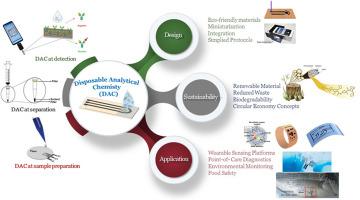一次性分析化学:设计、应用和可持续性
IF 12
1区 化学
Q1 CHEMISTRY, ANALYTICAL
引用次数: 0
摘要
一次性分析化学是一个快速发展的领域,其重点是一次性分析工具的开发和应用,在效率,价格合理和易于使用方面具有显着优势。这些平台越来越受欢迎,因为它们能够提供快速,准确的结果,而无需广泛的准备,使其成为医疗诊断,环境监测和食品安全应用的理想选择。微流体、传感器和材料科学的快速科技进步增强了一次性分析装置的能力,使它们能够以高灵敏度检测痕量化学浓度。通过开发诸如可生物降解聚合物和可持续制造技术等环保材料,解决了与一次性平台相关的环境问题。从传统方法到一次性设备的转变已经彻底改变了各个行业,提高了可持续性。这篇综述探讨了一次性分析化学的设计原理和未来潜力,强调了它在改善医疗保健、食品和环境应用方面日益增长的作用。本文章由计算机程序翻译,如有差异,请以英文原文为准。

Disposable analytical Chemistry: Design, application & sustainability
Disposable analytical chemistry is a rapidly developing field that focuses on the development and application of one-time-use analytical tools, offering significant advantages in efficiency, affordability and ease of use. These platforms are gaining popularity due to their ability to provide quick, accurate results without the need for extensive preparation making them ideal for applications in medical diagnostics, environmental monitoring and food safety. Rapid scientific and technological progresses in microfluidics, sensors and material science enhanced the capabilities of disposable analytical devices enabling them to detect trace chemical concentrations with high sensitivity. Environmental concerns related to disposable platforms are addressed through the development of eco-friendly materials such as biodegradable polymers and sustainable manufacturing techniques. The shift from traditional methods to disposable devices has revolutionized various industries enhancing sustainability. This review explores the design principles and future potential of disposable analytical chemistry highlighting its growing role in improving healthcare, food and environmental applications.
求助全文
通过发布文献求助,成功后即可免费获取论文全文。
去求助
来源期刊

Trends in Analytical Chemistry
化学-分析化学
CiteScore
20.00
自引率
4.60%
发文量
257
审稿时长
3.4 months
期刊介绍:
TrAC publishes succinct and critical overviews of recent advancements in analytical chemistry, designed to assist analytical chemists and other users of analytical techniques. These reviews offer excellent, up-to-date, and timely coverage of various topics within analytical chemistry. Encompassing areas such as analytical instrumentation, biomedical analysis, biomolecular analysis, biosensors, chemical analysis, chemometrics, clinical chemistry, drug discovery, environmental analysis and monitoring, food analysis, forensic science, laboratory automation, materials science, metabolomics, pesticide-residue analysis, pharmaceutical analysis, proteomics, surface science, and water analysis and monitoring, these critical reviews provide comprehensive insights for practitioners in the field.
 求助内容:
求助内容: 应助结果提醒方式:
应助结果提醒方式:


